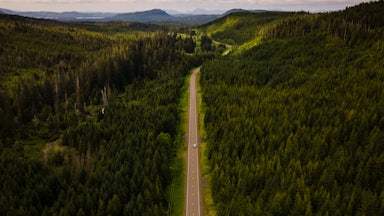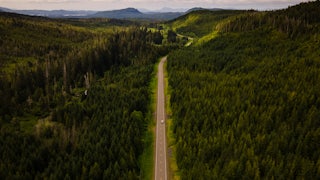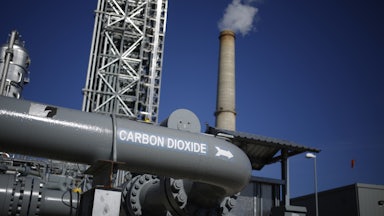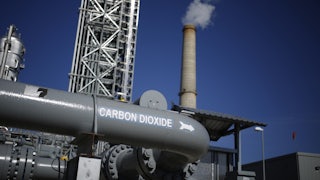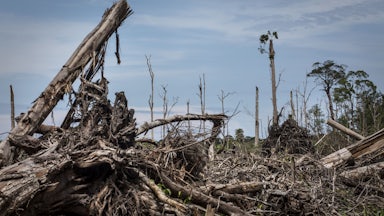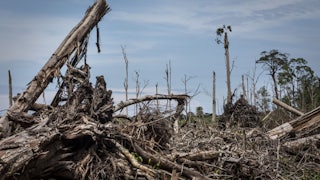What could be worth giving up a tenth of your country? The Liberian government reportedly plans to do exactly that and sell control of its intact rainforests to the scion of one of the world’s biggest fossil fuel producers.
A draft memorandum of understanding, leaked last month, between Liberia’s Ministry of Finance and Blue Carbon LLC—one of many companies started by a 38-year-old member of Dubai’s royal family, Ahmed Dalmook Al Maktoum—would commit the small African nation to hand over exclusive rights to one million hectares of forest lands. In exchange, Blue Carbon will transform that land into “environmental assets,” including carbon credits: essentially, sellable units of promised emissions reductions. Such credits are, in general, intended to offset actual pollution by businesses, individuals, or governments. They can be bought either as a voluntary means of reducing carbon footprints or as a way to comply with government climate goals and regulations.
For oil-rich countries like the United Arab Emirates—the host of this year’s U.N. climate talks, COP28—“carbon offset” schemes like the one described above hold incredible promise; the UAE is banking heavily on offsets to meet its own climate goals and has emphasized their importance in the lead-up to COP28. It’s a compelling pitch: Any emissions polluters can’t curb themselves can be outsourced to someone else. That basic premise undergirds everything from frothy corporate net-zero pledges to the decision to make your flight “carbon neutral” at checkout—and (arguably) the world’s hopes of limiting global temperature rise to 1.5 degrees Celsius (2.7 degrees Fahrenheit).
The only problem is that carbon offsets of all kinds are increasingly being outed as total bullshit.
Over the last few years, a drumbeat of academic research and investigative reporting has painted a bleak picture of carbon offsets and the carbon markets through which they’re traded. Just this week, a team of journalists at CarbonBrief published an exhaustive explainer on offsets and the many damning studies poking holes in a practice that’s long been a darling of climate policy wonks. That includes a study now making its way through the peer review process, which estimates that only 12 percent of carbon-offset projects “constitute real emissions reductions.”
There are well-documented cases, as well, of carbon credit developers engaging in human rights abuses and displacing Indigenous communities. An investigation published last week by The Guardian and the nonprofit watchdog Corporate Accountability found that 78 percent of the top 50 carbon-offset projects are “likely junk.”
That seemingly endless flow of reports has started to make an impact. The European Union is poised to crack down on unprovable “carbon neutral” claims that are often backed up by offsets. Even Shell—which boasted in 2021 about having delivered the first-ever “carbon neutral” liquefied natural gas cargo—quietly abandoned a $100 million-per-year plan last month to build out a pipeline of carbon credits en route to reaching net-zero emissions by 2050. Stateside, the Commodities Futures Trading Association has recently signaled that it intends to crack down on carbon credit fraud. Lawsuits are beginning to ramp up.
That increased scrutiny, though, has yet to spark a broader reckoning with what it means if carbon offsets can’t be counted on to meet climate goals: a far more drastic effort to reduce emissions in real time.
“There’s nothing happening today that wasn’t happening five years ago. It’s just that there was no one paying attention to it,” said environmental economist Danny Cullenward, a senior fellow at the University of Pennsylvania’s Kleinman Center for Energy Policy, whose research focuses on carbon offsets and storage.
The problems with “offsets” (a term of art describing a wide suite of activities) are definitional and fall into a few categories. Most have to do with the integrity of emission-reductions claims. Carbon credits are meant to correspond to emissions that have been avoided—say, through preventing trees from being razed—reduced, or removed, typically either through technologies such as direct air capture, which draws atmospheric carbon in through fans to then be stored in pipelines or injected underground, or “natural” methods like planting trees. Not much is natural, though, about buying up and seeding vast swathes of land with crops meant to serve a single purpose.
When it comes to credits generated from avoided emissions, there’s often little way of knowing whether a tract of forest, for instance, was ever actually in danger of being developed. Landowners can say they might bulldoze trees to sell off credits—even if they had no real plans to do so. Polluters who buy credits should be able to prove what’s known as “additionality”—the idea that their purchase made possible emissions reductions that wouldn’t have happened otherwise. But if the trees were never threatened, then the polluter who bought the credits hasn’t actually counteracted any of its own emissions.
Third-party verifiers that judge the integrity of carbon credits have been rocked by scandals. Some two-thirds of credits on the voluntary carbon market were verified by the Verified Carbon Standard, which is administered by an NGO called Verra. A months-long investigation by The Guardian, the German outlet Die Zeit, and a nonprofit newsroom called SourceMaterial, published in January, revealed that at least 90 percent of VCS-approved credits generated in the rainforest—popular among major brands like Disney and Gucci—were worthless “phantom credits” that didn’t correspond to any reductions. (Verra has refuted the allegations.)
Another major issue is who gets to claim carbon credits. If a wealthy country buys credits from a poorer one, does the country that financed those promised emissions reductions get to count them toward its climate goals? Or does the country where they were reduced? As of now, there are few protections against multiple parties staking a claim to the same credits.
Even more legitimate-seeming credits generated from forestry practices are likely unable to guarantee the emissions savings promised. Where a metric ton of carbon dioxide emitted from a coal plant will stay in the atmosphere permanently, with effects felt decades down the line, a metric ton of carbon stored in trees or avoided by saving more of them can be wiped out at virtually any point. True correspondence would require that carbon to be stored permanently. That’s a difficult promise to make. Even project operators who can honestly claim to be protecting as much carbon as they say, that is—based on the size and ecological makeup of the areas in question—can’t guarantee that carbon will be stored indefinitely.
California learned firsthand how that can go wrong. The state’s cap-and-trade system is premised on big polluters, including oil and gas drillers, buying up permits that correspond to emissions avoided through the protection of its vast forests. Those purchases allow a firm to make up the difference between emissions reductions in their own operations and a declining, state-mandated cap on how much they’re allowed to emit.
Included in that system is a “buffer” stock of additional forest lands set aside by project developers as insurance should other credit-generating trees burn. That buffer was meant to provide 100 years of protection against wildfire risk for California forest offsets. But over the last 10 years, 95 percent of those reserves have gone up in flames, releasing between 5.7 million and 6.8 million metric tons of carbon since 2015. While the country’s largest property insurer has almost entirely stopped taking out new policies in California, citing wildfire risk, the state agency that oversees California’s carbon market still only requires forest offset project developers to set aside an additional 2 to 4 percent of trees as insurance against wildfire risk. As a Mendocino County property called Eddie Ranch burned in 2018, its owners filed paperwork with that agency—the California Air Resources Board—to be paid millions for credits generated from preserving trees that were actively burning. Months later, CARB approved the application, “basing its decision on the state of the ranch before the fire,” the Los Angeles Times reported.
“The entire market is structured around a fundamental falsehood: that a ton of carbon we get from burning fossil fuels is identical to a ton of carbon stored in forests. That is 100 percent false,” Cullenward told me. “If you store carbon for less time than it takes to stabilize temperatures, that storage does not have any climate benefit.”
That’s one consequence, he explains, of seeing the world like an economist. On paper, carbon stored in trees and what’s emitted from a coal plant is all just carbon. Physical reality tells a different story. Companies relying on offset credits to meet net-zero goals typically only budget for cheap, low-quality projects likely to be worthless, or worse. High-quality offsets are exceedingly rare. More permanent carbon storage remains unproven at scale but is likely to be needed “at gigaton scale,” Cullenward says, just to stabilize temperatures.
After decades of scandals, there have been attempts to put some safeguards around carbon markets. Article 6.4 of the Paris Agreement creates a new U.N.-backed carbon market open to governments and companies alike to trade credits. Standards for that are being developed by a supervisory body composed of members from each U.N. regional group, and key elements will need to be approved by the countries that convene at annual U.N. climate meetings.
Article 6.2 is meant to govern bilateral carbon trading—agreements reached between countries, as opposed to a market where companies and governments can shop around for offsets or offer them up for sale as needed. As of now, that’s more of a Wild West, says Jonathan Crook, who tracks negotiations for the Brussels-based watchdog Carbon Market Watch. “Countries can more or less do what they want as long as they agree to it,” he said. “There are very few rules that need to be upheld in terms of integrity and additionality.”
Among the fears held by Carbon Market Watch and other advocates is that those transactions will turn into a black box. If changes agreed to at last year’s COP stick, countries will be able to keep details about trades confidential. While technical experts at the U.N. will be tasked with reviewing them, they would be forbidden from divulging information to the public. A report published by Carbon Market Watch this week puts forward a set of criteria for judging so-called negative emissions, emphasizing the need to ensure carbon is stored permanently and that such tools are used as a complement to rather than substitute for mitigation.
While bilateral trades can already happen, fully fleshed-out rules under 6.2 could stand to explode the market for such deals. As bad news about carbon offsets has multiplied, so too have troubling climate science and catastrophes fueled by rising temperatures. As pressure builds internationally, dramatic land grabs like the one Blue Carbon has pushed in Liberia could become more and more common. As of now, it’s all too likely that those could do more harm than good.

